The Anthropology Tutorials website will be taken offline on January 9, 2026.
Due to federal accessibility requirements taking effect in 2026, we will be removing this site. If you use materials from this site in your courses or research, please seek alternative resources.
Adapting to Climate Extremes
Humans and
many other mammals have unusually efficient internal temperature regulating systems that
automatically maintain stable core body
temperatures in cold winters and warm summers. In addition, people have
developed cultural patterns and technologies that help them adjust to extremes of
temperature and humidity.
In
very cold climates, there is a constant danger of developing
hypothermia
 , which is a life threatening drop in
core body
temperature to subnormal levels. The normal
temperature for humans is about 98.6° F. (37.0° C.). However, individual differences in metabolism
, which is a life threatening drop in
core body
temperature to subnormal levels. The normal
temperature for humans is about 98.6° F. (37.0° C.). However, individual differences in metabolism
 ,
hormone levels, physical activity, and even the time of day can cause it to be as much as 1°
F. (.6° C.) higher or lower in
healthy individuals. It is also normal for core body temperature to be
lower in elderly people. Hypothermia begins to occur when the
core body temperature drops to 94° F. (34.4°
C.). Below 85° F.
(29.4°C.), the body cools
more rapidly because its natural temperature regulating system
(in the hypothalamus
,
hormone levels, physical activity, and even the time of day can cause it to be as much as 1°
F. (.6° C.) higher or lower in
healthy individuals. It is also normal for core body temperature to be
lower in elderly people. Hypothermia begins to occur when the
core body temperature drops to 94° F. (34.4°
C.). Below 85° F.
(29.4°C.), the body cools
more rapidly because its natural temperature regulating system
(in the hypothalamus
 )
usually fails. The now rapid decline in core body
temperature is likely to result in death. However, there have been rare
cases in which people have been revived after their temperatures had dropped
to 57-60° F. (13.9-15.6°
C.). This happened in 1999 to a Swedish woman who was
trapped under an ice sheet in freezing water for 80 minutes. She was
found unconscious, not breathing, and her heart had stopped beating, yet she
was eventually revived despite the fact that her temperature had dropped to
56.7 F. (13.7 C.).
)
usually fails. The now rapid decline in core body
temperature is likely to result in death. However, there have been rare
cases in which people have been revived after their temperatures had dropped
to 57-60° F. (13.9-15.6°
C.). This happened in 1999 to a Swedish woman who was
trapped under an ice sheet in freezing water for 80 minutes. She was
found unconscious, not breathing, and her heart had stopped beating, yet she
was eventually revived despite the fact that her temperature had dropped to
56.7 F. (13.7 C.).
In
extremely hot climates or as a result of uncontrollable
infections, core body temperatures can
rise to equally fatal levels. This is hyperthermia
 .
Life threatening hyperthermia typically starts in
humans when their temperatures rise to 105-107° F. (40.6-41.7°
C.). Only a few days at this extraordinarily
high temperature level is likely to result in the deterioration of internal
organs and death.
.
Life threatening hyperthermia typically starts in
humans when their temperatures rise to 105-107° F. (40.6-41.7°
C.). Only a few days at this extraordinarily
high temperature level is likely to result in the deterioration of internal
organs and death.
Body size and
shape are significant factors in how efficiently an individual responds physiologically to
cold and hot climates. Two 19th century naturalists, Carl Bergmann and Joel Allen,
formulated rules concerning these factors.
Bergmann's
Rule
In 1847, the German
biologist Carl Bergmann
 observed that within
the same species of warm-blooded animals, populations having less massive individuals are
more often found in warm climates near the equator, while those with greater
bulk, or mass,
are found further from the equator in colder regions. This is due to the fact that
big animals generally have larger body masses which result in more heat being produced.
The greater amount of heat results from there being more cells. A normal
byproduct of metabolism in cells is heat production.
Subsequently, the more cells an animal has, the more internal heat it will
produce.
observed that within
the same species of warm-blooded animals, populations having less massive individuals are
more often found in warm climates near the equator, while those with greater
bulk, or mass,
are found further from the equator in colder regions. This is due to the fact that
big animals generally have larger body masses which result in more heat being produced.
The greater amount of heat results from there being more cells. A normal
byproduct of metabolism in cells is heat production.
Subsequently, the more cells an animal has, the more internal heat it will
produce.
In addition,
larger animals usually have a smaller surface area relative to their body mass and,
therefore, are comparatively inefficient at radiating their body heat off into the
surrounding environment. The relationship between
surface area and volume of objects was described in the 1630's by Galileo.
It can be demonstrated
with the cube shaped boxes
shown below. Note
that the volume increases twice as fast as the surface area.
This is the reason that relatively less surface
area results in relatively less heat being lost from
animals.
Comparison of cube surface areas
and volumes illustrating Bergmann's rule
|
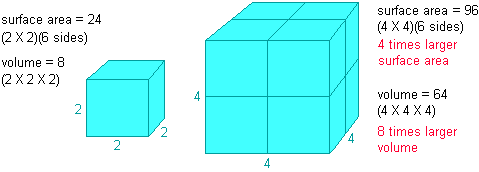 |
| |
Massive polar
bear bodies are
predicted by
Bergmann's rule |
|
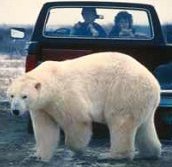 |
Polar bears are
a good example of this
phenomenon. They have large, compact bodies with relatively small
surface areas from which they can lose their internally produced heat. This is an
important asset in cold climates. In addition, they have heavy fur and fat
insulation that help retain body heat.
Bergmann's
rule generally holds for people as well. A study of 100 human
populations during the early 1950's showed a strong negative correlation between body mass and mean
annual temperature of the region. In other words, when the air
temperature is consistently high, people usually have low body mass.
Similarly, when the temperature is low, they have high mass.
However, there are exceptions. Our clothing and
technologies that allow us to keep buildings warm in the winter and cool in
the summer tend to offset the effects of natural selection now in shaping
our bodies. In addition, culturally guided mate selection criteria
also somewhat counter Bergmann's rule for humans.
|
Negative correlation
between
environmental temperature
and body mass in humans
and other warm blooded
animals |
|
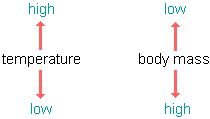 |
A corollary of Bergmann's
rule stated that a linear shaped mammal will lose heat to the environment
faster than a more compact one of similar size. The boxes below illustrate this fact.
Note that the long, narrow box has the same volume but greater surface area. It is
comparable to a tall, slender animal.
|
Comparison of different shaped
box surface areas and volumes
illustrating a corollary of
Bergmann's rule
relating to
body shape
|
|
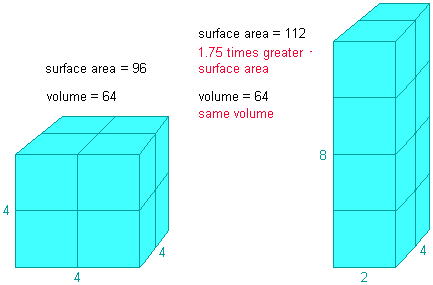 |
Allen's
Rule
In 1877, the American
biologist
Joel Allen went further than Bergmann in observing that
the length of arms, legs, and other
appendages also has an effect on the amount of heat lost to the surrounding
environment. He noted that among warm-blooded animals, individuals in populations of
the same species living in warm climates near the equator tend to have longer limbs than
do populations living further away from the equator in colder environments.
This is due
to the fact that a body with relatively long appendages is less compact and
subsequently has more surface area. The greater the surface area, the faster body
heat will be lost to the environment.
This
same phenomenon can be observed among humans. Members
of the Masai
 tribe of
East Africa are
normally tall and have slender bodies with long limbs that assist in the loss of body
heat. This is an optimal body shape in the hot tropical parts of the world but
it would
be a disadvantage in subarctic regions. In such extremely cold environments, a
stocky body with short appendages would be more efficient at maintaining body heat because
it would have relatively less surface area compared to body mass.
tribe of
East Africa are
normally tall and have slender bodies with long limbs that assist in the loss of body
heat. This is an optimal body shape in the hot tropical parts of the world but
it would
be a disadvantage in subarctic regions. In such extremely cold environments, a
stocky body with short appendages would be more efficient at maintaining body heat because
it would have relatively less surface area compared to body mass.
|
Slender
East Africans
with long arms
and legs
predicted by
Allen's rule |
|
 |
|
 |
|
|
|
|
Normal processes of body heat
loss in
a moderate climate |
We lose heat
to the surrounding environment in several ways, as shown in
the illustration above on the right. However, simple
radiation
is the process that is responsible for most of the loss, except in hot dry climates where
evaporative cooling, or sweating, can be more significant.
Cold
Climate Responses
Many people
living in freezing climates drink alcohol to warm themselves. This increases blood
flow to the body extremities, thereby providing a feeling of warmth. However, it
results only in a temporary warming and can speed up the loss of heat from the vital
internal organs, resulting in more rapid death from hypothermia.
A much more
effective cultural response to extremely cold temperatures is the use of insulating
clothing, houses, and fires. People all over the world also adapt by limiting
outdoor activities to warmer times of the day. In some societies, sleeping in
family groups with bodies
pushed up against each other
is also done in order to minimize heat loss
during the cold months of the year.
When
the environment is very cold, life can depend on the ability of our bodies to
reduce heat loss and to increase internal heat production. As Bergmann
and Allen observed, the human physiological response to cold commonly includes the
evolution of more massive, compact bodies with relatively less surface area.
However, short term acclimatization to the cold also occurs. A normal
initial physiological response is the narrowing of blood vessels near skin
surface (vasoconstriction). This
preserves core body heat by reducing peripheral blood flow. As a
consequence, the skin cools and less heat is lost from the body by
radiation. However, if the environmental temperature is below the
freezing point, prolonged vasoconstriction can result in dangerous frostbite.
As a consequence, the body's internal temperature regulating mechanism
responds by dilating the peripheral blood vessels (vasodilation),
thereby increasing the flow of warm blood near the skin surface. The
body normally alternates back and forth between vasoconstriction and
vasodilation to compensate for the risks of both conditions. This
cycling is known as the Lewis hunting phenomenon). Shivering
can also cause a short-term warming
effect. The increased muscle activity in
shivering results in some heat production.
There are three additional important types of
biological responses to cold conditions found among some human
populations around the world:
|
1. |
increased basal metabolic rate |
|
2. |
fat insulation of vital organs |
|
3. |
long term change in blood flow patterns |
People living in harsh subarctic regions, such as the Inuit
 (Eskimo) of the far northern regions of the western
hemisphere and the Indians of Tierra del Fuego at
the southern end,
traditionally consumed large quantities of high calorie fatty foods. This
significantly increases
the basal metabolic rate, which, in turn, results in the production of extra body heat.
These peoples also wore heavy clothing, often slept in a huddle with their
bodies next to each other, and remained active when outdoors.
(Eskimo) of the far northern regions of the western
hemisphere and the Indians of Tierra del Fuego at
the southern end,
traditionally consumed large quantities of high calorie fatty foods. This
significantly increases
the basal metabolic rate, which, in turn, results in the production of extra body heat.
These peoples also wore heavy clothing, often slept in a huddle with their
bodies next to each other, and remained active when outdoors.
|
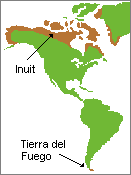 |
|
 |
| Inuit man |
The Ju/'hoansi
 of Southwestern Africa and the Aborigines
of Southwestern Africa and the Aborigines
 of Australia usually respond physiologically to the
cold in a different way. Thick fat insulation develops around the vital organs of
the chest and abdomen. In addition, their skin cools due to vasoconstriction at night.
As a result, heat loss is reduced
and the core body temperature remains at normal levels. However, the
skin feels very cold throughout the night.
of Australia usually respond physiologically to the
cold in a different way. Thick fat insulation develops around the vital organs of
the chest and abdomen. In addition, their skin cools due to vasoconstriction at night.
As a result, heat loss is reduced
and the core body temperature remains at normal levels. However, the
skin feels very cold throughout the night.

This response
would not be adaptive if the Ju/'hoansi and the Aborigines lived in consistently freezing
environments because the concentration of body heat in their torsos would allow the loss
of fingers, toes, and other appendages from frostbite.
The loss of fingers in particular would make it difficult for these hunters
and gatherers to acquire food.
Their physiological adaptation is to environments that rarely stay below freezing long and
that do not have abundant high calorie fatty foods.
Hot
Climate Responses
Adapting to
hot environments is as complex as adapting to cold ones. However, cold adaptation is
usually more difficult physiologically for humans since we are not
subarctic animals by
nature. We do not grow dense fur coats nor do we usually have thick layers of fat
insulation like polar bears. Despite this reality,
more people die from heat than cold in the United States every year.
Those who succumb are usually babies left in locked cars on hot days and the
elderly poor who cannot afford air conditioning.
The effect of
heat on our bodies varies with the relative humidity of the air. High temperatures
with high humidity make it harder to lose excess body heat. This is due to the fact
that when the moisture content of air goes up, it becomes increasingly more difficult for
sweat to evaporate. The sweat stays on our skin and we feel clammy. As a
result, we do not get the cooling effect of rapid evaporation.
 Evaporative
cooling experiment.
Put a little rubbing alcohol on the back of one of your
Evaporative
cooling experiment.
Put a little rubbing alcohol on the back of one of your
hands and water on
the back of the other. Wave them in the air. Feel
the difference as
they both evaporate. What did you learn
about evaporative cooling?
(HINT: alcohol is more
volatile than water--it evaporates more
rapidly. Therefore, the hand with alcohol replicates
sweating
in a very low humidity environment.) |
In dry, hot
weather, humidity is low and sweat evaporates readily. As a result, we usually feel
reasonably comfortable in deserts at temperatures that are unbearable in tropical rain
forests. The higher the desert temperatures, the more significant of a cooling
effect we get from evaporation. This relationship between relative humidity and air
temperature is quantified in the table below. When the apparent temperature is in the
light yellow range, heat exhaustion and cramps are likely for humans. In the bright
yellow range, life threatening heat stroke is likely.
 |
|
(
Source: U.C. Berkeley Wellness Letter,
Aug.1996) |
While
evaporative cooling is very effective in dry
climates, there is a major drawback. That is the rapid loss of water and salts from
the body through sweat. This can be fatal in less than a day if they are not
replaced. It is common to lose a quart or more of water through sweating each hour
in harsh summer desert conditions. Commercial "sport
drinks" are designed to help people in these situations rehydrate and
replenish lost mineral salts. It is easy and inexpensive to create your
own equivalent drink without the unnecessary food coloring and sugar that the
commercial drinks often include to make them more appealing to customers.
Diluted lemonade with added salt can satisfactorily serve the same purpose.
Most people
have the ability to physiologically acclimatize to hot conditions
over a period of days to weeks. The salt
concentration of sweat progressively decreases while the volume of sweat increases.
Urine volume also reduces. In addition, vasodilation of peripheral blood
vessels causes flushing, or reddening, of the skin
because more blood is close to the
surface. That blood brings heat from the core body
areas to the surface where it can be dissipated easily into the environment
by radiation.
Evaporative cooling also plays an
important protective role when vigorous physical activity results in
overheating of the body. Researchers at Osaka International University
and Kobe University in Japan have
discovered recently that men generally are more effective
at sweating than women when they do strenuous work or exercise. Men
usually begin sweating earlier and sweat more than women in response to the
same amount of exertion. This would imply that men and women are not
equal in heat tolerance. However, further research with different
populations around the world are necessary to verify this conclusion.
 Function of fever--could it be an
advantage in surviving infections?
Function of fever--could it be an
advantage in surviving infections?
This link takes you to an external website. To return here, you must click
the
"back" button on your browser program.
(length = 7 mins 32
secs) |
NOTE: Sweating is not only a mechanism for
getting rid of excess body heat. Our sweat contains a number of different
substances, including pheromones
 that can have powerful effects on the hormone systems of others who are
physically close to us. Researchers at the Monell Chemical Senses Center
in
Philadelphia have shown that pheromones in the sweat of men
can cause an increase in the amount of luteinizing hormones released from a
woman's pituitary gland at the base
of her brain. This in turn can shorten the time until the next
ovulation. Subsequently, human male pheromones are now being considered
as potential future fertility drugs for women. Pheromones released by sisters and
other women living together can cause a synchronization of their menstrual
cycles. It is likely that human males also respond subconsciously to
female pheromones in a way that affects their reproductive systems.
that can have powerful effects on the hormone systems of others who are
physically close to us. Researchers at the Monell Chemical Senses Center
in
Philadelphia have shown that pheromones in the sweat of men
can cause an increase in the amount of luteinizing hormones released from a
woman's pituitary gland at the base
of her brain. This in turn can shorten the time until the next
ovulation. Subsequently, human male pheromones are now being considered
as potential future fertility drugs for women. Pheromones released by sisters and
other women living together can cause a synchronization of their menstrual
cycles. It is likely that human males also respond subconsciously to
female pheromones in a way that affects their reproductive systems.
NEWS: In the
March 2, 2012 issue of the
Journal of Biological Chemistry, Wei Cheng et.al
reported that some human
nerve cells have proteins on their surfaces that
enable them to differentiate
between several different temperatures in the
mildly warm to hot range. This sensing ability may play an important role
in the way we respond physiologically to hot temperatures. A summary
version of this information is available in
ScienceDaily.
Copyright © 1998-2012 by Dennis O'Neil.
All rights reserved.
illustration credits
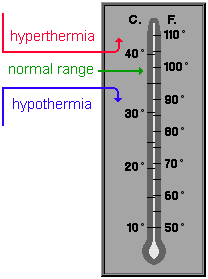
![]() , which is a life threatening drop in
core body
temperature to subnormal levels. The normal
temperature for humans is about 98.6° F. (37.0° C.). However, individual differences in metabolism
, which is a life threatening drop in
core body
temperature to subnormal levels. The normal
temperature for humans is about 98.6° F. (37.0° C.). However, individual differences in metabolism
![]() ,
hormone levels, physical activity, and even the time of day can cause it to be as much as 1°
F. (.6° C.) higher or lower in
healthy individuals. It is also normal for core body temperature to be
lower in elderly people. Hypothermia begins to occur when the
core body temperature drops to 94° F. (34.4°
C.). Below 85° F.
(29.4°C.), the body cools
more rapidly because its natural temperature regulating system
(in the hypothalamus
,
hormone levels, physical activity, and even the time of day can cause it to be as much as 1°
F. (.6° C.) higher or lower in
healthy individuals. It is also normal for core body temperature to be
lower in elderly people. Hypothermia begins to occur when the
core body temperature drops to 94° F. (34.4°
C.). Below 85° F.
(29.4°C.), the body cools
more rapidly because its natural temperature regulating system
(in the hypothalamus
![]() )
usually fails. The now rapid decline in core body
temperature is likely to result in death. However, there have been rare
cases in which people have been revived after their temperatures had dropped
to 57-60° F. (13.9-15.6°
C.). This happened in 1999 to a Swedish woman who was
trapped under an ice sheet in freezing water for 80 minutes. She was
found unconscious, not breathing, and her heart had stopped beating, yet she
was eventually revived despite the fact that her temperature had dropped to
56.7 F. (13.7 C.).
)
usually fails. The now rapid decline in core body
temperature is likely to result in death. However, there have been rare
cases in which people have been revived after their temperatures had dropped
to 57-60° F. (13.9-15.6°
C.). This happened in 1999 to a Swedish woman who was
trapped under an ice sheet in freezing water for 80 minutes. She was
found unconscious, not breathing, and her heart had stopped beating, yet she
was eventually revived despite the fact that her temperature had dropped to
56.7 F. (13.7 C.).![]() .
Life threatening hyperthermia typically starts in
humans when their temperatures rise to 105-107° F. (40.6-41.7°
C.). Only a few days at this extraordinarily
high temperature level is likely to result in the deterioration of internal
organs and death.
.
Life threatening hyperthermia typically starts in
humans when their temperatures rise to 105-107° F. (40.6-41.7°
C.). Only a few days at this extraordinarily
high temperature level is likely to result in the deterioration of internal
organs and death.![]() observed that within
the same species of warm-blooded animals, populations having less massive individuals are
more often found in warm climates near the equator, while those with greater
bulk, or mass,
are found further from the equator in colder regions. This is due to the fact that
big animals generally have larger body masses which result in more heat being produced.
The greater amount of heat results from there being more cells. A normal
byproduct of metabolism in cells is heat production.
Subsequently, the more cells an animal has, the more internal heat it will
produce.
observed that within
the same species of warm-blooded animals, populations having less massive individuals are
more often found in warm climates near the equator, while those with greater
bulk, or mass,
are found further from the equator in colder regions. This is due to the fact that
big animals generally have larger body masses which result in more heat being produced.
The greater amount of heat results from there being more cells. A normal
byproduct of metabolism in cells is heat production.
Subsequently, the more cells an animal has, the more internal heat it will
produce.








